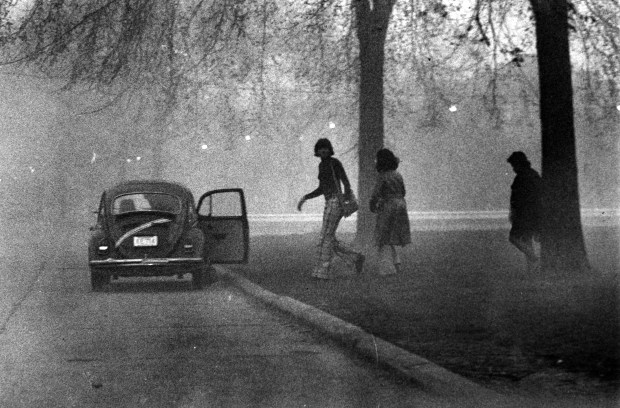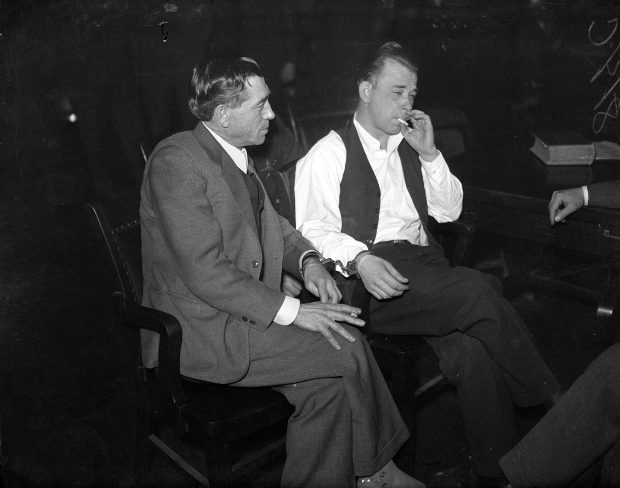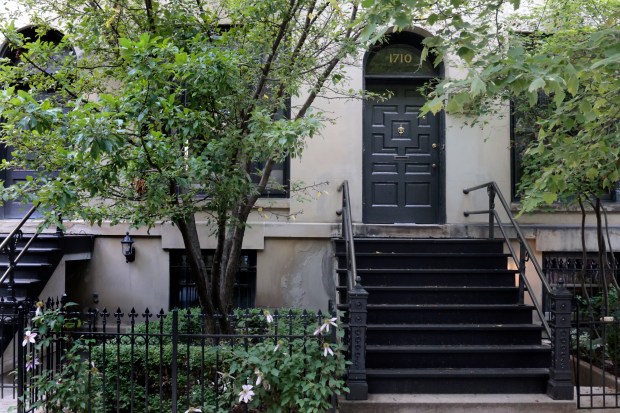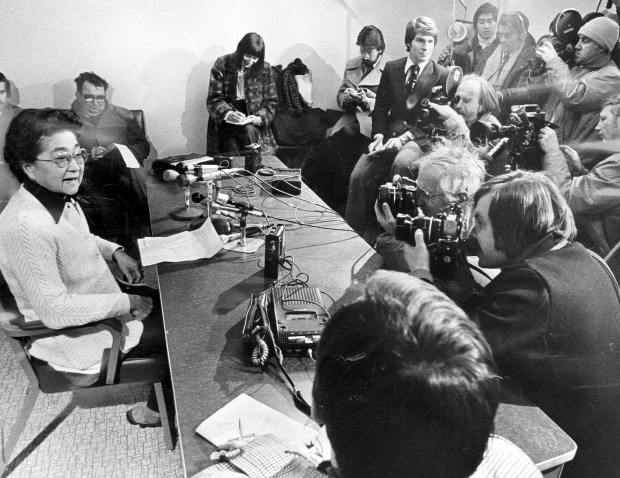Year Three of the Vintage Chicago Tribune newsletter closes — and what a significant year 2024 was.
We poured through the Tribune’s archives to say goodbye to WGN-TV chief meteorologist Tom Skilling; we explored how Chicagoans of bygone eras observed solar eclipses and dealt with cicada invasions; and we wished happy 100th birthday to WLS radio and the Silver Football competition. A few of our favorite finds are detailed below.
Paul Durica, however, provided the most entertaining posts of the year thanks to his daily review of Tribune newspapers from 1924.
And we were honored to appear on WTTW’s “Chicago Mysteries” with host Geoffrey Baer to chat about Foolkiller No. 3.
More major anniversaries and important events from the city’s past lie ahead in 2025. That’s why we’re excited to launch a second edition of the Vintage Chicago Tribune newsletter on Mondays. Consider it our version of an almanac chock-full of key moments that have shaped Chicago. And look for Kori’s daily “Today in Chicago history” dispatches on chicagotribune.com.
What would you like to see in this newsletter? Email us.
Today in Chicago History: Oprah Winfrey debuts on ‘A.M. Chicago’
Did you miss a week? Here’s a comprehensive list — with a few special editions.
Jan. 4: Oprah Winfrey — 10 moments from her Chicago years
Jan. 11: The blizzard of 1979 — and how it propelled Jane Byrne into the mayor’s office
Jan. 18: Meet the city’s polka royalty
Jan. 25: The pardon of ‘Tokyo Rose’
Feb. 1: Revisiting 1924
Feb. 8: St. Valentine’s Day massacre
Feb. 15: Inventions and innovations by Black Chicagoans
Feb. 22: 10 facts about Tom Skilling’s long and storied career
Feb. 29: Leap year milestones
March 7: Paul Durica’s February 1924 finds
March 14: The city’s St. Patrick’s Day traditions
March 21: What to know about Mundelein, a century after his elevation as Chicago’s first cardinal
March 28: Hippity, hoppity Easter traditions
April 3: Solar eclipses and how Chicagoans viewed them
April 4: ‘Prettiest woman ever accused of murder in Chicago’
April 11: 100 years of WLS — the ‘World’s Largest Store’ — radio
April 15: Exploring ‘Chicago Mysteries’
April 18: Paul Durica’s March 1924 finds
April 25: The paper’s role in the demise of Richard Nixon’s presidency after Watergate
May 2: Cicada invasion
May 9: Paul Durica’s April 1924 finds
May 16: Nathan Leopold and Richard Loeb
May 23: American Airlines Flight 191 crashed near O’Hare International Airport 45 years ago; these are the 273 victims
May 30: The Field Museum evolves — take a look back as it turns 130
June 6: Paul Durica’s May 1924 finds — death, disappearances and demolition
June 13: Metra — ‘The way to really fly’ — turns 40
June 20: The Great Seiche — or was it? — of 1954; what was behind Lake Michigan’s most unusual phenomenon?
June 27: Koala-crazy — A look back at when Lincoln Park Zoo welcomed the marsupials in 1988
July 4: Paul Durica’s June 1924 finds
July 11: Millennium Park — ‘The best thing former Mayor Richard M. Daley ever did’ — 20 years later
July 18: John Dillinger’s final days — and the ‘Lady in red’ who helped trap him
July 25: Summer Olympians from the area who won gold
Aug. 1: Paul Durica’s July 1924 finds
Aug. 7: Remembering the Dave Matthews Band bus incident, 20 years later
Aug. 8: Illinois Lottery’s first drawing took place 50 years ago
Aug. 15: Celebrating 100 years of the Silver Football
Aug. 22: Tradition of acceptance speeches at political conventions began in Chicago
Aug. 29: How the Tully monster became Illinois’ official state fossil
Sept. 5: Paul Durica’s August 1924 picks
Sept. 12: How the Anti-Superstition Society celebrated Friday the 13th
Sept. 19: Remembering the Go-Go White Sox
Sept. 26: Paul Durica’s September 1924 finds
Oct. 3: Pope John Paul II’s visit — 45 years ago
Oct. 10: 10 infamous people condemned to Stateville prison
Oct. 17: Ghost stories from Chicagoland
Oct. 24: Unearthing the lives of Graceland Cemetery’s lesser known residents with Adam Selzer
Oct. 31: How Svengoolie has evolved as the city’s iconic ghost host
Nov. 7: Paul Durica’s October 1924 finds
Nov. 14: Ron Grossman’s favorite stories
Nov. 21: Thanksgiving Parade turns 90
Nov. 28: Chicago Bears vs. Detroit Lions — a Thanksgiving tradition
Dec. 5: Revisiting ‘Home Alone’ sites with the film’s location manager
Dec. 12: Paul Durica’s November 1924 picks
Dec. 19: It’s not the holiday season without …
Dec. 26: Paul Durica’s top picks from 1924
Kori’s pick: The pardon of ‘Tokyo Rose’
Iva Toguri D’Aquino, once known as Tokyo Rose, speaks to the press at a news conference after she was pardoned by President Gerald Ford on Jan. 19, 1977. (Ernie Cox, Jr./Chicago Tribune)
When Iva Toguri moved to Chicago in 1956, she was determined to lead a quiet life. Her desire for anonymity was understandable.
Toguri’s name had been intertwined with the notorious label “Tokyo Rose” since World War II. The American-born daughter of Japanese immigrants was charged with broadcasting propaganda on Tokyo’s airwaves that toyed with the morale of American military personnel. When she became the second woman convicted of treason in the United States, she was also labeled a traitor, stripped of her citizenship and sent to federal prison.
Marianne’s pick: Living in a Far South Side ‘toxic doughnut,’ Hazel Johnson fought for environmental justice

Hazel Johnson wasn’t out to bug the bureaucrats when she tried to speak at a meeting of the Illinois Environmental Protection Agency in 1984. She just wanted to say something about the facts of life for residents of Altgeld Gardens, a public housing complex on Chicago’s Far South Side.
The air she and her neighbors breathed there was palpably unhealthy. Their homes were surrounded by smoke-belching industries.
Kori’s pick: John Dillinger’s final days — and the ‘Lady in red’ who helped trap him

John Herbert Dillinger arrived in the Chicago area in July 1923, for a respectable reason — he joined the U.S. Navy. But few knew the enlistment was an attempt by the machinist-in-training at Naval Station Great Lakes to beat an auto theft charge in Indiana. Or, that he would desert his ship, the USS Utah — and military life altogether — while it was docked in Boston just six months later. That left a dishonorable discharge on Dillinger’s record and set him on a course of violence.
Dillinger ducked the authorities until 90 years ago. His Chicago whereabouts were given up by a woman desperate to clear her own name.
Marianne’s pick: Country’s first documented gay rights organization started 100 years ago in Old Town

A century ago, Henry Gerber founded America’s first documented gay rights organization in a boardinghouse at 1710 N. Crilly Court in Chicago.
It was once part of a complex of townhouses built for well-heeled newlyweds. Today it sits amid Old Town’s mix of high-rise condos and renovated brownstones.
A plaque in the sidewalk outside the building where he lived on the second floor notes it is a Chicago landmark, explaining that the home was where Gerber wrote at least the first of the two published issues of “Friendship and Freedom,” the first documented gay periodical in America.
But in his day, Gerber’s neighbors were society’s outcasts. Prostitutes worked in rooms on either wing of Crilly Court. Being off the beaten path was fine with him. He didn’t want his address to be generally known.
We both loved: Paul Durica’s top picks from 1924

Paul Durica said, “The decision to read each day’s newspaper from 1924 came from a realization that two events that have meant a lot to my work occurred in the same calendar year. Those events are the kidnapping and murder of 14-year-old Robert Franks by Nathan Leopold Jr. and Richard Loeb, considered the crime of the century at the time, and the passage by the United States Congress of the nation’s most restrictive piece of immigration legislation.
“I wondered what else happened in 1924 and what would I learn by letting the year unfold day by day, in real time. Much from that year is still remembered, while many events, meaningful in their moment, have faded from memory.”
Want more vintage Chicago?
- Read Today in Chicago History
- Become a Tribune subscriber: It’s just $12 for a 1-year digital subscription
- Follow us on Instagram: @vintagetribune
- Join our Chicagoland history group on Facebook
Thanks for reading!
Have an idea for Vintage Chicago Tribune? Share it with Kori Rumore and Marianne Mather at krumore@chicagotribune.com and mmather@chicagotribune.com





